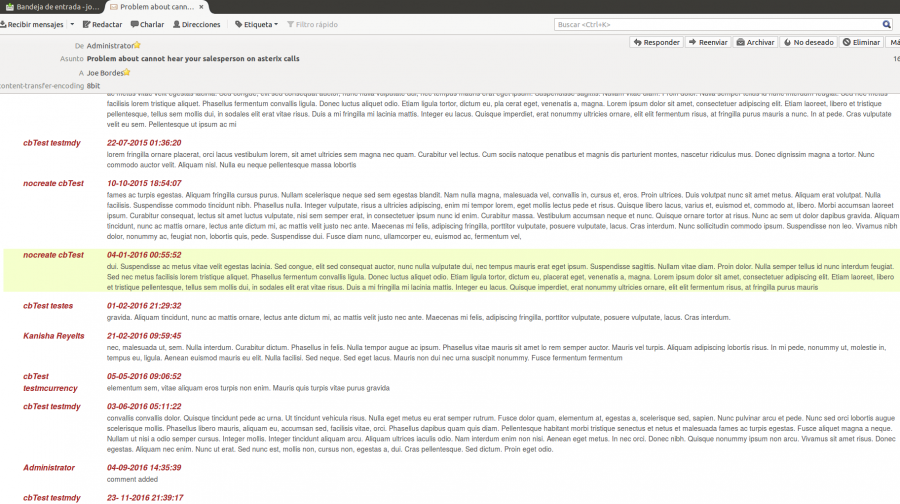Meta Variables
Comments
This metavariable was created to support the help desk process and permits you to add and format a list of the comments on the ticket to your email.
It also supports the FAQ module and all the other modules that have comments. So, although unlikely, you could send all the comments on an opportunity to the related account or contact, or, more interesting, send them to the user in charge of the opportunity when one is added.
The syntax of this meta variable is:
$(general : (__VtigerMeta__) [dateformat_]comments[_num[sort][_format[_field]]])where:
| dateformat | Optional PHP standard date formatting syntax that will be applied to all dates. If not given the date format of the user executing the command will be used |
| num | engine to be used for processing templates. Handlebars is the default |
| dateformat | picklist |
| sort | Indicates the number of comments you want, 0 will retrieve all comments |
| format | text, HTML or table |
| field | creator, comment, date, all: indicates the field to retrieve |
Examples
| comments | returns all comments sorted ascending in HTML format, see below for exact format |
| comments_1d_text_comment | return in text format the last comment added |
| comments_1d_text | return all three fields (creator, date and comment) in text format of the last comment added. Each field will be ended with a new line character |
| comments_4d | returns last 4 comments in HTML format |
| comments_4a | returns first 4 comments in HTML format |
| comments_4 | returns first 4 comments in HTML format |
| comments_0d | returns all comments sorted descending in HTML format |
| comments_0d_text | returns all comments sorted descending in text format |
| d.M.Y - H:i_comments | returns all comments sorted ascending in HTML format, with specific date format |
Styles and Formats
In text format mode the value of the field will be returned with no additional characters unless you asked for all the fields, in that case, each field will be ended with a new line character.
The creator field will be returned as the first and last name of the user or contact.
The date field will be formatted to the settings of the user assigned to the ticket launching the workflow.
The comment field will be stripped of any inline style or scripts to avoid potential hacks or compromises of clients' computers.
In HTML format mode all fields will be returned in an unordered list element (UL). Each comment will be in its own DIV which will contain the unordered list and contain each field being returned in its own list item (LI).
The whole set of comments will be enclosed in a DIV element.
So the structure looks like this:
<div class="comments">
<div class="commentdetails">
<ul class="commentfields">
<li class="commentcreator">...</li>
<li class="commentdate">...</li>
<li class="commentcomment">...</li>
</ul>
</div>
...
</div>Since each element has its own class you can add inline CSS to your email and format the comments as you like.
As an example, this CSS:
<style type="text/css">
.comments {
margin: 10px
}
.commentfields {
color: brown;
list-style-type: none;
}
.commentfields:hover {
background-color: #F5FFCC;
}
.commentcreator {
position: absolute;
font: bold italic 16px/1.5 Helvetica, Verdana, sans-serif;
word-wrap: normal;
width: 160px;
}
.commentdate {
font: bold italic 16px/1.5 Helvetica, Verdana, sans-serif;
padding-left: 170px;
}
.commentcomment {
font: 14px/1.5 Helvetica, sans-serif;
padding-left: 170px;
color: #555;
}
</style>will produce the output you can see in the next image which is from my email reader (thunderbird) with the hover effect captured:

Inventory Details
Very similar to the Comments we can do the same with the product lines in the inventory modules.
The syntax of this meta variable is:
$(general : (__VtigerMeta__) inventorydetails[_format[_field]]])where:
| format | text, HTML or table |
| field | quantity, listprice, extgross, linetotal, or * for all fields. pdoname is always present as the name of the product or service |
Related Lists
Very similar to the Comments we can do the same with the related lists of the main module of the email.
The syntax of this meta variable is:
$(general : (__VtigerMeta__) relatedlist_relatedmodulename[_format[_field]]])where:
| relatedmodulename | related module name. if the given module is not related the list will be empty |
| format | text, HTML or table |
| field | list of fields to show |
Next | Chapter 2: Contacts2Accounts.